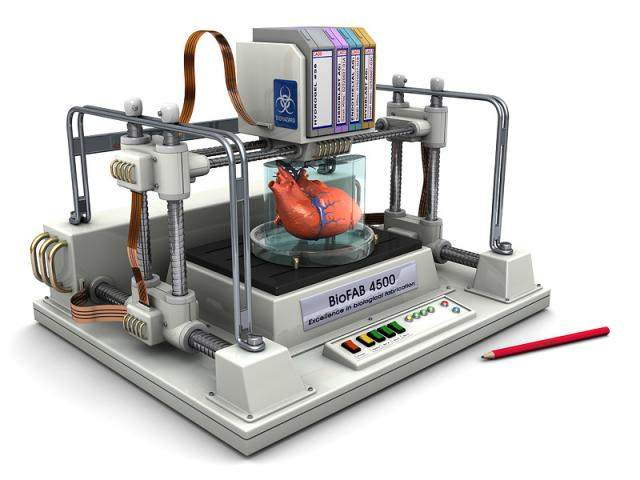A report from Gartner says that 3D printing will create debate on ethics and regulation. Furthermore, analysts expect that rapid development of 3D Bioprinters will spark calls to ban the technology for human and non-human use by 2016.
3D bioprinting is the medical application of 3D printing to produce living tissue and organs. It is progressing so quickly that it analysts at Gartner believe it will spark a major ethical debate on its use by 2016. Additionally, according to the same report, 3D printing of non-living medical devices such as prosthetic limbs, combined with a burgeoning population and insufficient levels of healthcare in emerging markets, is likely to cause an explosion in demand for the technology by 2015.
“3D bioprinting facilities with the ability to print human organs and tissue will advance far faster than general understanding and acceptance of the ramifications of this technology,” said Pete Basiliere, research director at Gartner.
Already in August 2013, the Hangzhou Dianzi University in China announced it had invented the biomaterial 3D printer Regenovo, which printed a small working kidney that lasted four months. Earlier in 2013, a two-year-old child in the US received a windpipe built with her own stem cells.

Mr. Basiliere added: “These initiatives are well-intentioned, but raise a number of questions that remain unanswered. What happens when complex ‘enhanced’ organs involving nonhuman cells are made? Who will control the ability to produce them? Who will ensure the quality of the resulting organs?”

It may be that the day when 3D-bioprinted human organs are readily available is closer than we realize, almost sneaking up on us unexpectedly, and Gartner believes it will result in a complex debate involving a great many political, moral and financial interests.
The ability to build customized human anatomical parts has pervasive appeal in medical device markets — especially in economically weak and war-torn regions — where it addresses high demand for prosthetic and other medical devices. In addition, increasing familiarity within the material sciences and computer-augmented design services sectors, and integration with healthcare and hospitals, will further increase demand from 2015 onwards.
“The overall success rates of 3D printing use cases in emerging regions will escalate for three main reasons: the increasing ease of access and commoditization of the technology; ROI; and because it simplifies supply chain issues with getting medical devices to these regions,” said Mr. Basiliere. “Other primary drivers are a large population base with inadequate access to healthcare, in regions often marred by internal conflicts, wars or terrorism.”
Outside the medical market, 3D printing will also bring about major changes and challenges. Gartner predicts that by 2018, at least seven of the world’s top 10 multichannel retailers will be using 3D printing technology to generate custom stock orders, at the same time as entirely new business models are built on the technology.
“Some retailers are already selling 3D printers to consumers, and as they become more readily available, consumers could use them to ‘manufacture’ their own custom-designed products,” said Miriam Burt, research vice president at Gartner. “We also expect to see 3D copying services and 3D printing bureaus emerge where customers bring 3D models to a retailer or provider and have increasingly high-end parts and designs printed, not just in plastics but in materials including ceramics, stainless steel, and cobalt and titanium alloys.”
The rapid emergence of this technology will also create major challenges in relation to intellectual property (IP) theft. Gartner predicts that by 2018, 3D printing will result in the loss of at least $100 billion per year in IP globally.
“The very factors that foster innovation — crowdsourcing, R&D pooling and funding of start-ups — coupled with shorter product life cycles, provide a fertile ground for intellectual property theft using 3D printers,” said Mr. Basiliere. “Already, it’s possible to 3D print many items, including toys, machine and automotive parts, and even weapons.”
In this environment, businesses will find it increasingly difficult to fully monetize their inventions, and licensees of related IP will be less able to achieve the maximum benefit of their licenses. IP thieves will have reduced product development and supply chain costs, enabling them to sell counterfeit goods at a discount, while unsuspecting customers are at risk of poorly performing and possibly even dangerous products.
The analysis is available in the report “Predicts 2014: 3D Printing at the Inflection Point.”
Gartner analysts will provide additional analysis on these predictions during the Gartner webinar, “Gartner Predicts a Disruptive IT Future” on March 13 at 8 a.m. and 11 a.m. EST. To register for this complimentary webinar, please visit here.






